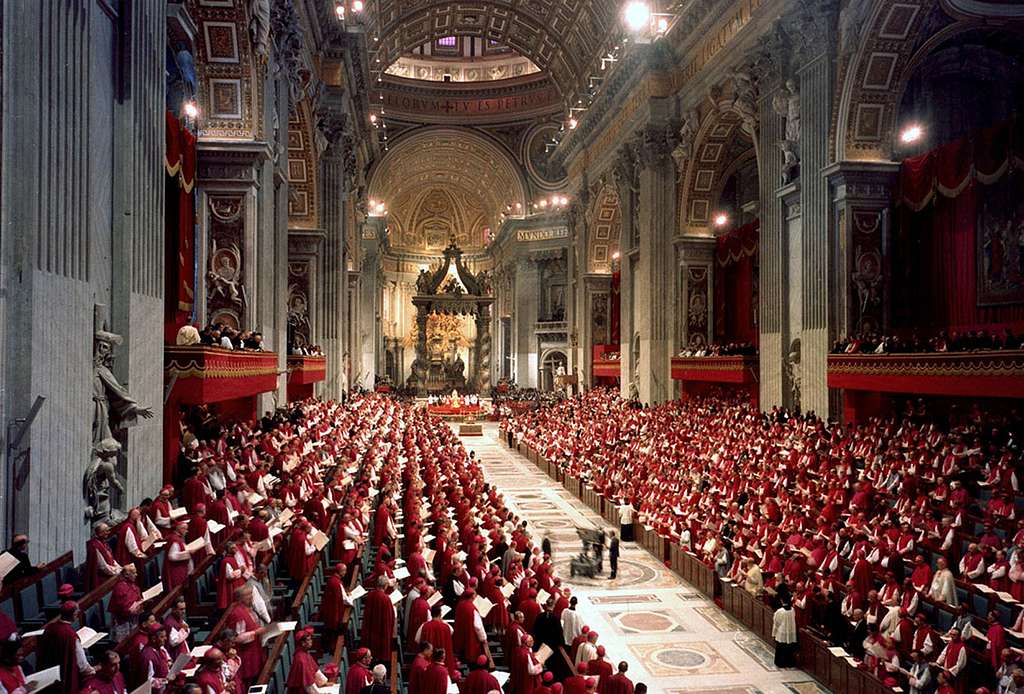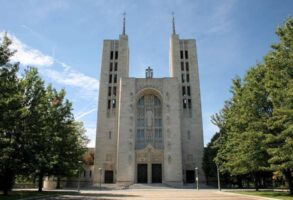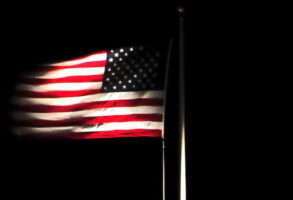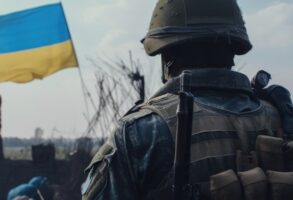
Published October 1, 2022
The Second Vatican Council, which opened 60 years ago on Oct. 11, 1962, was the most important Catholic event in half a millennium. Its achievements were many and notable; it was also followed by ecclesiastical upheavals that continue to roil the Church today.
After Vatican II, Catholics worshiped in their own languages, rather than in Latin. By urging Catholics to become more biblically literate, the council inspired lay communities of spiritual renewal, some of them robustly charismatic. It also led to greater lay participation in all aspects of Church life: liturgical, educational, managerial, evangelical. The council fully inserted Catholicism into the ecumenical movement’s quest for Christian unity, even as it dramatically reconfigured the Church’s relationship to its religious parent, Judaism.
Vatican II was also the moment in which Catholicism fully realized its claim to be a global (“catholic”) institution, as churchmen from outside the Church’s historic European core began to take prominent roles in shaping the Catholic future. The extraordinary growth of the Catholic Church in sub-Saharan Africa—where Catholicism now counts hundreds of millions of adherents, many of them first- or second-generation Christians—was accelerated by the council’s promotion of native African clergy and religious orders, its disentanglement of Catholicism from colonialism and its insistence on the Church’s essentially missionary character.
Had there been no Second Vatican Council, the Catholic Church of the 21st century would look rather different. So would world politics. The council’s seminal Declaration on Religious Freedom, which recognized that the altar-and-throne alliances of the past were not possible under modern political conditions, helped to transform the Church from a bulwark of the status quo into one of the world’s foremost institutional defenders of basic human rights. Absent Vatican II, it is difficult to think of a pope coming from Poland or to imagine that pope playing a pivotal role in one of contemporary history’s great transformations: the self-liberation of Central and Eastern Europe in the 1989 collapse of European communism.
On this 60th anniversary, however, critics of Vatican II and its implementation will emphasize other realities of post-conciliar Catholic life. In the decade after the council concluded on Dec. 8, 1965, tens of thousands of priests and religious sisters abandoned their rectories and convents, in the largest such exodus since the 16th-century Reformations. The council wanted the Mass, the central act of Catholic worship, to be more accessible and participatory, thereby giving Catholics a deeper sense of the spiritual amplitude within which this world exists. Instead, the Mass was too often dumbed down into banality, if not downright silliness.
Catholic activists, especially in Latin America, tried to concoct an impossible synthesis between Christianity and Marxism, with disastrous political, economic and social results still evident in places like Venezuela, Nicaragua, Peru and even Mexico. The once-thriving Catholicism of Western Europe—countries whose theologians and bishops were the principal movers-and-shakers at Vatican II—has largely disappeared since the council, replaced by a Church of the Zeitgeist that seems far more liberal-Protestant and woke-progressive than Catholic. Post-conciliar breakdowns in seminary training and the discipline of the clergy were major contributors to the crimes of clerical sexual abuse. And then there is the scandal of Catholic public officials who, inaccurately claiming the warrant of Vatican II’s call for a dialogue with the world of political power, promote public policies that contradict both Catholic teachings and the moral truths the Church holds we can know by reason.
Given that mixed picture over the past six decades, the question inevitably poses itself on this diamond anniversary: Was Vatican II really necessary?
It was.
Understanding why means coming to grips with the full truth about Pope John XXIII and his purposes for the council he summoned. And that requires getting beyond the mythology of Pope John as a jolly old Italian nonno (grandfather) who wanted to let a thousand ecclesiastical flowers bloom.
Angelo Giuseppe Roncalli, elected Bishop of Rome on Oct. 28, 1958, as an elderly placeholder, took a different path to the papacy than many of his predecessors. They were the sons of aristocrats or socially well-placed professionals; his people were dirt-poor northern Italian peasants. Rather than being a theologian or a canon lawyer, his intellectual interest was history, and especially the Church-reforming work of St. Charles Borromeo in 16th-century Milan—a previous moment of social, political and ecclesiastical turmoil.
An Italian army chaplain in World War I, Roncalli was a Vatican diplomat in the Balkans, Greece and Turkey during the cataclysm of World War II. In those largely non-Catholic European peripheries, he provided Jews fleeing the Nazi Holocaust with false baptismal certificates and helped facilitate Jewish emigration to Palestine. Immediately after the war, he was sent as Vatican representative to a shattered, demoralized France. There, he witnessed a local Church, bitterly divided between royalists and republicans since the French Revolution, struggle to reignite Christian faith among alienated workers and existentialist intellectuals.
Promoted to Patriarch of Venice and given the cardinal’s red hat as the Catholic equivalent of the faithful employee’s gold watch, Roncalli experienced the Italian Church’s weaknesses beneath what seemed to be its rock-solid position in society and culture. All this gave him a distinctive optic on the mid-20th-century pathologies of world civilization and convinced this conservative man of traditional piety that the Church’s approach had to change.
In 1962, the influential German magazine Der Spiegel editorialized admiringly that, after 2,000 years, the Catholic Church “had achieved a unity and consistency in teaching and structure never seen before… It possesses ‘a single truth’ and a single custodian of that truth.” The “custodian” knew better. From his historical studies and pastoral experience, John XXIII knew that the defensive Catholicism of the Counter-Reformation, however successful a salvage operation, had run its course. It was time to raze the bastions that Catholicism had erected and turn its robust institutions into platforms for evangelization and mission in order to engage a deeply troubled modern world. The Church, he believed, existed to proclaim and compassionately witness to Christian truth for the world’s healing and sanctification. It could not hide that truth like the frightened servant in Christ’s parable of the talents (Luke 19:12-28).
In Pope John’s adult lifetime, that world had come close to committing civilizational suicide twice, in two global wars that took perhaps 80 million lives. The world was now precariously balanced on the razor’s edge of an even greater catastrophe, nuclear war. Such a world, materially rich but spiritually impoverished, needed a positive, ennobling vision of human nature, human community and human destiny. The dangers confronting humanity, John XXIII believed, were the byproducts of false ideas about who we are, how we ought to live together and where the human story was going. By re-energizing the Church for a mission of proclaiming the truths about our humanity revealed in the person, teaching and work of Jesus Christ, the incarnate Son of God, Vatican II would help the world rediscover humanity’s true “dignity [and] purposes,” as the pope put it in the document solemnly convoking the council.
In his opening address to Vatican II, John XXIII suggested how ecclesiastical renewal would take place. The council, he said, should rekindle the evangelical fire of Christocentric faith that had animated the first Christians and their bold mission. “Christ Jesus,” the octogenarian pope boldly claimed, “still stands at the center of history and life.” Reanimated by that conviction, the Church would develop the means to express ancient and enduring truths in ways that modernity could hear.
Contrary to the claims of those votaries of Pope Francis who claim that the council instituted a “paradigm shift” in the Church’s self-understanding, John XXIII did not convoke Vatican II to reinvent Catholicism. As he put it in his opening address, the council’s “greatest concern” must be the more effective presentation of Catholic truth in full, what the pope called “the sacred deposit of Christian doctrine.”
That would not happen, however, if the Church merely guarded this “precious treasure…as if we were only concerned with an antiquity.” Nor would it suffice to repeat familiar formulas of faith, like those in the simple, question-and-answer catechisms that Catholics had long known. The Church had to do more, and Pope John borrowed from the work of the great English theologian, John Henry Newman, to describe a truly Catholic development of doctrine: “What…is necessary today is that the whole of Christian doctrine…be more fully and profoundly known…[and] presented in the way demanded by our times. For the deposit of faith, the truths contained in our venerable doctrine, are one thing; the fashion in which they are expressed, but with the same meaning and the same judgment, is another thing.”
So the Church would propose, and in a vocabulary that the people of the modern world could hear and engage. The council was not summoned, however, to discard the essential truths that the Church had proposed for two millennia. For as the pope went on to say, “it is clearer than ever before that the truth of the Lord remains forever” (Psalm 116:2). Moreover, that “truth of the Lord” is, in fact, the Lord himself: “To the human race, laboring under so many difficulties, [the Church] says, as Peter once did to the unfortunate man who begged him for alms, ‘Silver and gold have I none, but what I have I give you: in the name of Jesus Christ the Nazarene, rise and walk’” (Acts 3:6). Jesus Christ, not the Church, must be the center of the Catholic proclamation.
The more radical Catholic traditionalists of our day seem to imagine that the Catholic bastion of the mid-20th century could have sustained itself indefinitely. If that were true, however, why did that way of being Catholic crumble so quickly in Ireland, Québec, Spain and Portugal? And why did those men and women most recently formed in pre-conciliar seminaries and novitiates lead the flight from the priesthood and consecrated religious life?
Thoughtful assessments of Vatican II and its legacy must acknowledge that the pre-conciliar Catholic past was more brittle and fragile after two world wars, and more vulnerable to the cultural tsunami of the 1960s, than some nostalgic traditionalists imagine. Moreover, bunker Catholicism is a betrayal of the great commission that was central to John XXIII’s original intention for Vatican II: “Go…and make disciples of all nations, baptizing them in the name of the Father and of the Son and of the Holy Spirit, teaching them all that I have commanded you” (Matthew 28:19-20).
Sixty years after Pope John opened the council by proposing a Christ-centered humanism capable of animating just and humane societies, an empirical fact is worth noting: Amid crises, challenges and persecutions, the flourishing parts of the world Church today are those that have accepted his call to a mission that offers friendship with Jesus Christ as the answer to the question that is every human life, and that live that mission compassionately in the fullness of Catholic faith.
By contrast, those sectors of the world Church that have taken Vatican II as an invitation to teach and live Catholic Lite are demonstrating that Catholic Lite leads inevitably to Catholic Zero. In 2022, the vibrant parts of a globalized Catholicism are those living John XXIII’s original intention for Vatican II as a council that would renew the Church for its mission of sanctifying an often claustrophobic, self-absorbed and frightened world. Those that misconstrue Vatican II as a call to embrace secular modernity uncritically rather than to engage and convert it are dying, because they fail to offer the world a Christ-centered medicine for its ills.
John XXIII often spoke of his hope that Vatican II would be a “new Pentecost,” recalling the descent of the Holy Spirit on the Apostles. The council he imagined was not a business meeting in which the branch officers of a global enterprise discussed ways to increase market share in a stable cultural and social environment. Pope John intended Vatican II to be an event in the realm of the spirit: an experience of the love of God breaking into the world anew. That experience, this man of deep faith hoped, would not only console but re-enliven a world beset by the fear that is the corrosive byproduct of spiritual emptiness.
Realizing that intention remains a noble and urgent task for Catholics today.
George Weigel, Distinguished Senior Fellow of the Ethics and Public Policy Center, is a Catholic theologian and one of America’s leading public intellectuals. He holds EPPC’s William E. Simon Chair in Catholic Studies.
George Weigel, Distinguished Senior Fellow of the Ethics and Public Policy Center, is a Catholic theologian and one of America’s leading public intellectuals. He holds EPPC’s William E. Simon Chair in Catholic Studies.











